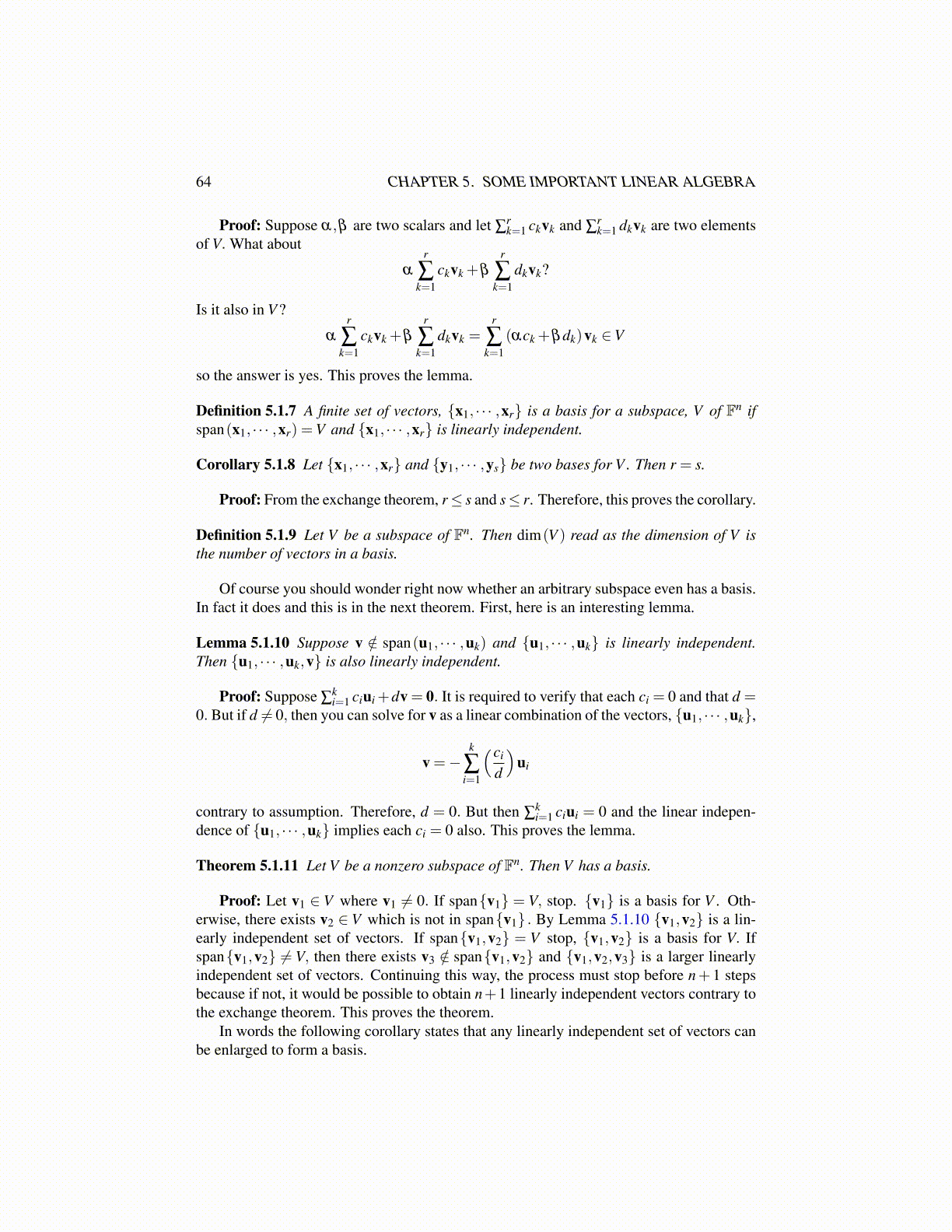
64 CHAPTER 5. SOME IMPORTANT LINEAR ALGEBRA
Proof: Suppose α,β are two scalars and let ∑rk=1 ckvk and ∑
rk=1 dkvk are two elements
of V. What about
α
r
∑k=1
ckvk +β
r
∑k=1
dkvk?
Is it also in V ?
α
r
∑k=1
ckvk +β
r
∑k=1
dkvk =r
∑k=1
(αck +βdk)vk ∈V
so the answer is yes. This proves the lemma.
Definition 5.1.7 A finite set of vectors, {x1, · · · ,xr} is a basis for a subspace, V of Fn ifspan(x1, · · · ,xr) =V and {x1, · · · ,xr} is linearly independent.
Corollary 5.1.8 Let {x1, · · · ,xr} and {y1, · · · ,ys} be two bases for V . Then r = s.
Proof: From the exchange theorem, r≤ s and s≤ r. Therefore, this proves the corollary.
Definition 5.1.9 Let V be a subspace of Fn. Then dim(V ) read as the dimension of V isthe number of vectors in a basis.
Of course you should wonder right now whether an arbitrary subspace even has a basis.In fact it does and this is in the next theorem. First, here is an interesting lemma.
Lemma 5.1.10 Suppose v /∈ span(u1, · · · ,uk) and {u1, · · · ,uk} is linearly independent.Then {u1, · · · ,uk,v} is also linearly independent.
Proof: Suppose ∑ki=1 ciui +dv = 0. It is required to verify that each ci = 0 and that d =
0. But if d ̸= 0, then you can solve for v as a linear combination of the vectors, {u1, · · · ,uk},
v =−k
∑i=1
(ci
d
)ui
contrary to assumption. Therefore, d = 0. But then ∑ki=1 ciui = 0 and the linear indepen-
dence of {u1, · · · ,uk} implies each ci = 0 also. This proves the lemma.
Theorem 5.1.11 Let V be a nonzero subspace of Fn. Then V has a basis.
Proof: Let v1 ∈ V where v1 ̸= 0. If span{v1} = V, stop. {v1} is a basis for V . Oth-erwise, there exists v2 ∈ V which is not in span{v1} . By Lemma 5.1.10 {v1,v2} is a lin-early independent set of vectors. If span{v1,v2} = V stop, {v1,v2} is a basis for V. Ifspan{v1,v2} ̸= V, then there exists v3 /∈ span{v1,v2} and {v1,v2,v3} is a larger linearlyindependent set of vectors. Continuing this way, the process must stop before n+ 1 stepsbecause if not, it would be possible to obtain n+1 linearly independent vectors contrary tothe exchange theorem. This proves the theorem.
In words the following corollary states that any linearly independent set of vectors canbe enlarged to form a basis.